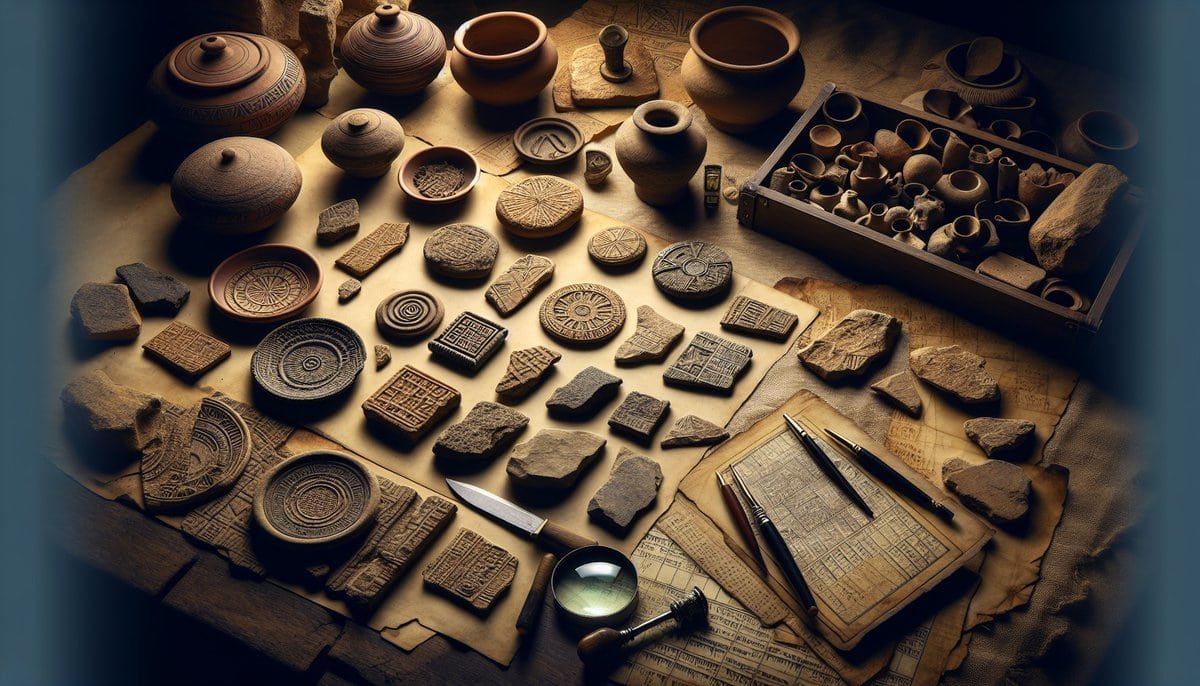In this article, one can discover the fascinating world of biblical archaeology and how it aids in understanding ancient folklore and mythology. With an emphasis on decoding ancient myths, this field of study provides invaluable insights into the cultures and civilizations of the past. By examining artifacts, ruins, and historical texts, researchers are able to piece together the stories and beliefs of ancient societies, shedding light on the origins and meanings behind biblical narratives. By exploring the role of biblical archaeology, one can gain a deeper appreciation for the myths and legends that have shaped human history.
Decoding Ancient Myths: The Role of Biblical Archaeology
Introduction to Biblical Archaeology
Biblical archaeology is a fascinating field of study that aims to uncover and interpret the historical and cultural context of ancient myths found in the Bible. It combines the disciplines of archaeology and biblical studies to shed light on the stories, beliefs, and practices of the ancient civilizations mentioned in biblical texts. By excavating ancient sites, discovering artifacts, and examining historical records, biblical archaeologists bring these ancient myths to life and help us understand the worldviews of our ancestors.
Importance of Studying Ancient Myths
Studying ancient myths is crucial for understanding the cultural heritage of a civilization. Myths often serve as a reflection of a society’s beliefs, values, and traditions. By unraveling these myths, archaeologists gain insights into the religious practices, social structures, and even political ideologies of ancient societies. Additionally, these ancient stories provide a glimpse into the human experience throughout history and allow us to connect with our past on a deeper level. By studying biblical myths, we can better comprehend the foundations of Western civilization and the religions that have shaped our world.
Methods and Techniques in Biblical Archaeology
Biblical archaeologists employ a variety of methods and techniques to investigate ancient myths. Excavation is one of the primary methods used, involving the careful removal of layers of soil and debris to uncover ancient artifacts, structures, and tombs. This process helps archaeologists piece together the puzzle of past civilizations and gain insight into their daily lives. Additionally, the use of remote sensing technologies such as ground-penetrating radar helps identify potential archaeological sites without extensive digging. Archaeologists also rely on the analysis of ancient texts, including historical records and inscriptions, to cross-reference biblical accounts and uncover further evidence.
Unraveling Biblical Mythology
Exploring Creation Myths
Creation myths play a significant role in many ancient civilizations, and biblical myths are no exception. These stories offer explanations for the origin of the world, the existence of life, and the relationship between humans, gods, and nature. Biblical archaeologists explore creation myths to understand the beliefs and cosmology of ancient societies, providing valuable insights into their worldview and religious practices.
Stories of Gods and Heroes
The biblical texts are filled with stories of gods and heroes who shaped ancient civilizations. From the mighty feats of Samson and the bravery of David to the divine interventions of Moses and Elijah, these stories shed light on the characteristics and actions revered by ancient societies. Biblical archaeologists delve into these stories to unravel their historical context, cultural significance, and potential connections to real individuals and events.
Interpreting Symbolism in Myths
Symbols hold great importance in myths, often representing abstract concepts, spiritual beliefs, or cultural values. In biblical archaeology, deciphering these symbols is crucial for understanding the deeper meanings embedded in the myths. By studying artifacts, artwork, and ancient texts, archaeologists work to decode the symbolic language employed in biblical myths, allowing us to gain a more profound understanding of the messages conveyed by ancient societies.

The Historical Significance
Historical Context of Ancient Myths
Ancient myths are not mere fictional tales; they are often deeply intertwined with historical events and cultural practices. By studying the historical context surrounding these myths, biblical archaeologists can uncover the societal forces that shaped them. Examining the political, social, and economic landscapes of ancient civilizations can provide valuable insights into why certain myths emerged, how they evolved, and what role they played in shaping society.
Linking Myths to Real Events and Places
Biblical archaeology seeks to corroborate the accounts found in ancient myths with actual historical events and physical locations. By discovering and excavating sites mentioned in the Bible, archaeologists can establish a connection between the myths and the tangible evidence of the past. This process helps validate the historical accuracy of the myths while providing a more comprehensive understanding of the cultures that produced them.
Understanding Ancient Worldviews
Ancient myths provide a window into the worldviews of the civilizations that created them. By studying these myths, biblical archaeologists gain insights into the religious beliefs, moral frameworks, and philosophical ideas that guided ancient societies. Understanding these worldviews helps us appreciate the diversity of human thought across time and enables us to grasp the societal and cultural foundations upon which our present beliefs and values are built.
The Role of Archaeology
Discovering Ancient Artifacts and Tombs
Archaeology plays a vital role in unearthing ancient artifacts and tombs, providing tangible evidence of the myths and stories found in biblical texts. Excavations have yielded a wide range of artifacts, including pottery, jewelry, weapons, and even human remains. These material remnants help confirm the existence of ancient civilizations, validate historical events, and offer insights into the daily lives, rituals, and artistic expressions of the people who lived during those times.
Excavating Ancient Cities and Civilizations
Biblical archaeology has led to the excavation of numerous ancient cities and civilizations, bringing to light lost worlds and forgotten cultures. The careful excavation of these sites provides valuable information about the urban planning, architecture, agriculture, and trade practices of ancient societies. By piecing together the physical remains of these cities, archaeologists construct a comprehensive picture of the civilizations in which biblical myths were born.
Reconstructing Lost Cultures and Practices
Archaeology not only uncovers ancient artifacts and cities but also allows for the reconstruction of lost cultures and practices. By analyzing the material remains and studying the surrounding archaeological context, biblical archaeologists can reconstruct aspects of ancient life, including religious rituals, social structures, and daily routines. This insight into the cultural practices associated with biblical myths enhances our understanding of the people who lived thousands of years ago and provides a more nuanced interpretation of their beliefs.

Archaeological Proof of Biblical Accounts
Comparing Archaeological Evidence with Biblical Texts
One of the main goals of biblical archaeology is to compare the archaeological evidence with the accounts described in biblical texts. By cross-referencing the two sources, archaeologists aim to establish a comprehensive understanding of the historical nature of biblical myths. When the evidence aligns with the texts, it provides strong confirmation of the events and people described. However, discrepancies between the archaeological record and the biblical account can also shed light on the historical context and cultural biases present in the texts.
Finding Confirmation of Historical Events
Archaeology has provided significant confirmation of historical events mentioned in biblical texts. For example, the discovery of the Tel Dan Stele corroborates the existence of the biblical King David, a figure of great importance in Jewish history. Similarly, the Moabite Stone mentions the biblical figure of Balak, providing external validation of his existence. These archaeological findings reinforce the historical reliability of the Bible and deepen our understanding of the people and events mentioned within its pages.
Examining the Exodus and Conquest of Canaan
The accounts of the Exodus from Egypt and the subsequent conquest of Canaan are central to the biblical narrative. Biblical archaeology has sought to substantiate these accounts by investigating archaeological evidence. While the interpretations and the dating of some findings remain debated, discoveries such as the Merneptah Stele mentioning the Israelites and the remains of ancient fortifications at Jericho have sparked discussions about the historical basis of these biblical events.
Myths and Legends in the Old Testament
The Great Flood and Noah’s Ark
The story of the Great Flood and Noah’s Ark is among the most well-known biblical myths. Through archaeological research, scholars have explored flood narratives from various ancient cultures, seeking commonalities and potential historical events that might have inspired these stories. Although concrete evidence for a global flood remains elusive, the presence of flood myths in cultures around the world suggests the possibility of a shared cultural memory of localized catastrophic events.
The Tower of Babel
The Tower of Babel is another prominent myth found in the Old Testament. Archaeologists have searched for evidence of ancient towers and ziggurats that could have inspired this story. While no conclusive evidence has been found to directly support the account, the discovery of ancient structures like the ziggurat of Etemenanki in Babylon and the existence of multilingual societies during the time period offer valuable insights into the cultural, linguistic, and architectural context of the biblical myth.
Sodom and Gomorrah
The destruction of Sodom and Gomorrah is a myth whose location and historical basis have intrigued scholars. Archaeologists have identified several potential sites, such as Tall el-Hammam, where evidence of a catastrophic event supports the possibility of a historical basis for the biblical account. While more research is needed to establish a definitive connection between the archaeological findings and the myth, these investigations contribute to our understanding of the ancient Near East and the cultural memory of devastating events.
Unearthing Ancient Cities
Exploring Ancient Jerusalem
Jerusalem holds immense significance in biblical archaeology as it was the center of ancient Israelite religion and kingship. The city has been extensively excavated, revealing layers upon layers of ancient history. From the ruins of the Jebusite city to the remains of the First and Second Temples, archaeologists have unearthed valuable artifacts and structures that shed light on the religious practices, political power, and daily life of the ancient Israelites.
The City of David
The City of David, located just south of the Temple Mount in Jerusalem, is of particular interest to biblical archaeologists. It is considered the oldest settled part of Jerusalem and is associated with King David’s reign. Excavations in this area have revealed numerous ancient structures, water systems, and artifacts, providing valuable insights into the biblical account of David and the early Israelite monarchy.
Jericho: Excavating the Oldest City
Jericho, one of the oldest inhabited cities in the world, is another significant site for biblical archaeology. The excavation of Jericho has revealed the remains of ancient walls, buildings, and a tower, dating back to the time period described in the biblical account of Joshua’s conquest. While there are debates regarding the dating and interpretation of the findings, the excavation at Jericho contributes to our understanding of ancient city planning and warfare during biblical times.
Ancient Cultures and Religions
Canaanite Religion and Israelite Influence
The religion of the Canaanites, the indigenous people of the land of Canaan, is closely connected to the beliefs and practices described in the Old Testament. Through archaeological excavations at sites such as Ugarit and Megiddo, researchers have uncovered evidence of Canaanite religious rituals, deities, and mythological texts. These findings provide insights into the religious milieu in which the Israelites emerged and shed light on the cultural exchanges and theological developments that shaped biblical traditions.
Egyptian Mythology and Influences
Egyptian mythology had a profound influence on many ancient Near Eastern cultures, including the Israelites. The biblical accounts of Moses and the Exodus depict interactions between the Israelites and the pharaohs of Egypt. By studying Egyptian archaeology and deciphering hieroglyphic inscriptions, biblical archaeologists trace the connections and influences of Egyptian religion, language, and cultural practices on the Israelites.
Mesopotamian Beliefs and Connections
The ancient civilizations of Mesopotamia, including the Sumerians, Babylonians, and Assyrians, also played a significant role in shaping the cultural backdrop of biblical myths. Archaeological discoveries in Mesopotamia have revealed clay tablets with ancient texts, such as the Enuma Elish creation myth and the Epic of Gilgamesh, which bear striking similarities to stories found in the Old Testament. These parallels highlight the cultural exchanges and shared mythological motifs between these civilizations and the ancient Israelites.
The Role of Biblical Figures
Investigating the Lives of Biblical Figures
Biblical archaeology offers unique insights into the lives and stories of the individuals mentioned in the Bible. By examining archaeological evidence and textual records, researchers delve into the biographies and cultural contexts of biblical figures. For example, the discovery of inscriptions mentioning Pontius Pilate provides corroborating evidence for his historical existence and role in the trial of Jesus. The investigation of biblical figures enhances our understanding of the historical events and sociopolitical dynamics depicted in the Bible.
Uncovering the Identity of Moses
Moses, the central figure of the Exodus narrative, continues to intrigue both scholars and believers alike. Biblical archaeology investigates the historical basis for the story of Moses and his leadership of the Israelites out of Egypt. While concrete evidence regarding Moses himself remains elusive, archaeological research has shed light on the cultural milieu and political context in which the Exodus story might have emerged, adding depth to our understanding of this pivotal figure in biblical history.
King David: Myth or Reality?
King David, the renowned psalmist and ruler of ancient Israel, is both a figure of historical significance and the subject of legendary accounts. Archaeological excavations in Jerusalem, particularly in the City of David, have uncovered evidence of a monarchic complex and fortifications that align with the time period associated with David’s reign. While questions remain and interpretations are subject to ongoing scholarly debate, these findings contribute to the ongoing quest to uncover the historical reality behind the myth of King David.
Debunking or Validating Myths
Challenging Mythical Accounts
Biblical archaeology does not merely seek to validate biblical myths but also to critically examine and interpret them in light of archaeological data. Scholars carefully scrutinize the historical, cultural, and geographical details of the biblical accounts, identifying potential inconsistencies or anachronisms. By challenging these mythical accounts, archaeologists contribute to a more nuanced understanding of the texts and their historical contexts.
Separating Fact from Fiction
Deciphering the historical accuracy of biblical myths requires discernment and critical analysis. By applying rigorous archaeological methodologies and comparing the textual accounts with physical evidence, biblical archaeologists strive to separate fact from fiction. While not every mythical detail has a direct correlate in the archaeological record, the interdisciplinary approach of biblical archaeology helps distinguish the historical kernel from the layers of cultural and theological interpretation that often accompany ancient texts.
Relevance of Myths in Modern Society
Despite the ancient origins of biblical myths, they continue to resonate with contemporary society. Myths express universal themes and enduring truths about the human condition, making them relevant across cultures and throughout time. Biblical archaeology provides insight into the historical context of these myths, enriching our interpretation and enabling us to engage with their relevance in the modern world. By understanding the ancient myths of the Bible, we can better appreciate the timeless wisdom they offer and their enduring impact on human culture and belief systems.






